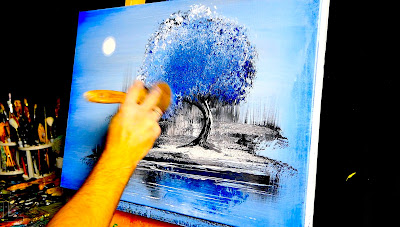Blue paint is ubiquitous in our world, from the vibrant hues adorning our homes to the calming shades used in hospitals. Yet, the history of this color is surprisingly rich and full of unexpected twists.

Early Beginnings: A Rare and Precious Color
The earliest evidence of blue paint dates back to prehistoric times, where cave paintings in Africa and Europe utilized natural pigments like lapis lazuli and azurite. These minerals were rare and highly valued, making blue paint a symbol of wealth and status.
In ancient Egypt, blue was associated with royalty and divinity. The pharaohs adorned themselves with blue jewelry and used blue pigments to paint their tombs and sarcophagi. Lapis lazuli was particularly prized for its intense color and was used to create stunning objects like the famous Tutankhamun mask.
The Rise of Cobalt Blue: A New Era in Color
The 17th century saw a revolution in blue paint with the introduction of cobalt blue. This synthetic pigment offered a more affordable and consistent alternative to natural blues, making it accessible to a wider range of artists and artisans.
Cobalt blue quickly became a favorite of painters like Vermeer and Van Gogh, who used it to create some of the most iconic artworks in history. Its vibrant shade and versatility solidified blue’s place as a cornerstone of the artist’s palette.
Beyond the Canvas: Blue’s Impact on Society
Blue’s influence extends far beyond the realm of art. In the 18th century, the discovery of synthetic indigo dye made blue fabrics readily available for the first time. This democratization of color led to a surge in the popularity of blue clothing, especially among the working class.
Blue’s association with calmness and order also made it a natural choice for uniforms, from military garments to police officers’ outfits. In the modern world, blue continues to hold cultural significance, symbolizing peace, trust, and security.
From Prussian Blue to Digital Blues: A Constant Evolution
The 18th century also saw the invention of Prussian blue, a pigment known for its intense dark blue shade. This pigment was widely used in printing and later became a favorite of artists like Turner and Monet.
In the 20th century, the development of new synthetic pigments like phthalocyanine blue further expanded the range of available blue shades. These modern pigments are more durable and lightfast, making them ideal for a wide range of applications, from industrial paints to digital displays.
The Future of Blue: A Color for Innovation
Today, blue remains a vital color in design, art, and technology. New technologies like OLED displays continue to push the boundaries of color representation, allowing for ever more vibrant and nuanced blues.
As we move into the future, blue is likely to continue playing a significant role in our lives. From the calming hues used to create relaxing environments to the vibrant shades used to represent innovation and progress, blue promises to remain a dominant force in the world of color.
Conclusion:
The surprising history of blue paint reveals a fascinating story of innovation, cultural influence, and artistic expression. From its humble beginnings in prehistoric caves to its contemporary applications in technology and design, blue has consistently captivated and inspired us. As we continue to explore the possibilities of this remarkable color, we can be sure that blue will remain a vibrant and essential part of our world for generations to come.
…::::: Download / View book :::::…
